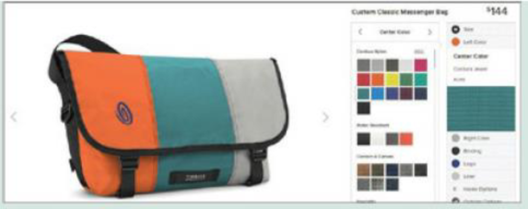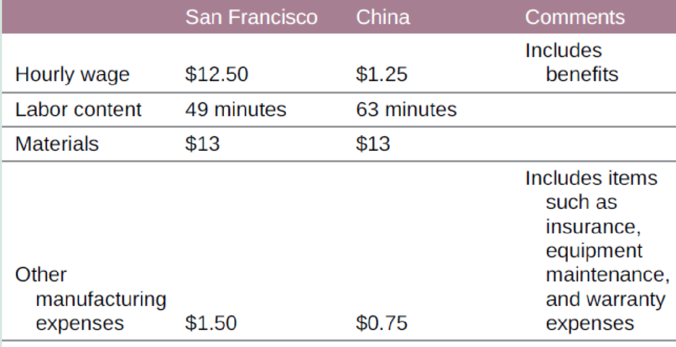
Concept explainers
Rob Honeycutt created Timbuk2 to offer consumers the ability to make their own custom, three-panel messenger bags. And instead of following the standard strategy of manufacturing in Asia, Rob set up Timbuk2 in San Francisco with its own facility. But is this the best strategy? Should Timbuk2 consider moving production to China?
The image above displays a screenshot from Timbuk2’s online retailing website that allows customers to customize their messenger bag to their own particular tastes. A customer can select one color for each of the three panels and a separate color, if they want, for the Timbuk2 “swirl” logo. The color options change over time, to keep things “fresh,” but at any one time Timbuk2 generally offers at least 16 options for each panel and the logo.
Once customized, Timbuk2 manufactures the bag in San Francisco and then ships the bag to the customer within two to three days.
Timbuk2 sells bags through its online store for about $100 per bag. Although it would love to sell bags only through its website and to sell many more of them, the market for custom bags at this price point is only so big. So Timbuk2 sells bags through other channels as well. For example, retailers such as REI purchase a limited selection of bags to sell in their stores. While Timbuk2 appreciates sales through this wholesale channel, they don’t generate the same revenue per bag as the online channel—more like $35 per bag. Even though the wholesale bags generally do not involve nearly the same level of customization as the online bags (i.e., retailers tend to select more conservative color combinations), those bags are made on the same production line as the online bags. However, the promised lead time to wholesale customers is longer, more like two to three weeks.

Courtesy of TIMBUK2
The decision as to whether to send production to China involves a number of issues. Table 11.11 provides a cost comparison between production in San Francisco and in China. There is clearly a dramatic difference in labor costs on a per-hour basis, but the workers in San Francisco are slightly more productive (they require 49 minutes per bag instead of 63 minutes). Material costs do not differ between the two options, because in both cases materials are procured in China. It costs $1 per bag to send it from China via ocean carrier, but the lead time is probably eight weeks when all of the steps are accounted for (e.g., production, movement to the port, and actual shipping). To get a faster lead time would require air shipments, but that is much more expensive: $15 per bag.
TABLE 11.11 Production and Shipment Costs per Bag by Production Location


Of course, Table 11.11 doesn’t tell the entire story. There would be costs associated with finding a good supplier and monitoring that supplier. And it isn’t clear how Timbuk2’s customers would react to the move—from its start, Timbuk2 emphasized with pride that it was made in San Francisco. Does moving production to China eliminate part of the brand’s cache with customers?
Should it move production of custom bags to China? Should it move production of wholesale bags to China?
Want to see the full answer?
Check out a sample textbook solution
Chapter 11 Solutions
OPERATIONS MANAGEMENT
Additional Business Textbook Solutions
Principles of Economics (MindTap Course List)
Financial Accounting, Student Value Edition (5th Edition)
Operations Management: Processes and Supply Chains (12th Edition) (What's New in Operations Management)
Horngren's Cost Accounting: A Managerial Emphasis (16th Edition)
MARKETING:REAL PEOPLE,REAL CHOICES
Intermediate Accounting (2nd Edition)
- Identify the causes of the problem. -Start by Reviewing the Inputs box in the Organizing Framework to help you identify the causes of the problem in this case. First identify the person factors and then situation factors as inputs. -Then move to the Processes box in the Organizing Framework and review the potential causes among individual level, team level and organizational level factors. -For each cause explain why this is a cause of the problem. For each cause ask yourself “why” is this a cause to the problem we identified. Remember that asking why multiple times will help you find the root cause of the problem.arrow_forward6. Develop a POQ solution and calculate total relevant costs for the data in the following table. Period 1 2 3 4 5 6 7 8 9 10 11 12 Gross requirements 30 40 30 70 20 10 80 50 Holding cost =$2.50/unit/week Holding cost =$2.50/unit/week; setup cost =$150setup cost =$15 0; lead time =1 week lead time =1 week; beginning inventory =40beginning inventory =40.arrow_forward5. Develop a lot-for-lot solution and calculate total relevant costs for the data in the following table. Period 1 2 3 4 5 6 7 8 9 10 11 12 Gross requirements 30 40 30 70 20 10 80 50 Holding cost =$2.50/unit/week Holding cost =$2.50/unit/week; setup cost =$150setup cost =$15 0; lead time =1 week lead time =1 week; beginning inventory =40beginning inventory =40.arrow_forward
- 4. The demand for subassembly S is 100 units in week 7. Each unit of S requires 1 unit of T and 2 units of U. Each unit of T requires 1 unit of V, 2 units of W, and 1 unit of X. Finally, each unit of U requires 2 units of Y and 3 units of Z. One firm manufactures all items. It takes 2 weeks to make S, 1 week to make T, 2 weeks to make U, 2 weeks to make V, 3 weeks to make W, 1 week to make X, 2 weeks to make Y, and 1 week to make Z. Construct a net material requirements plan using the following on-hand inventory. Item On hand inventory Item Inventory On hand S 20 W 30 T 20 X 25 U 40 Y 240 V 30 Z 40arrow_forward3. WestJet’s daily flight from Edmonton to Toronto uses a Boeing 737, with all-coach seating for 120 people. In the past, the airline has priced every seat at $140 for the one-way flight. An average of 80 passengers are on each flight. The variable cost of a filled seat is $25. Katie Morgan, the new operations manager, has decided to try a yield-revenue approach, with seats priced at $80 for early bookings and at $190 for bookings within one week of the flight. She estimates that the airline will sell 65 seats at the lower price and 35 at the higher price. Variable cost will not change. Which approach is preferable to Ms. Morgan?arrow_forward2. A large Saskatchewan feed mill, B. Swart Processing, prepares its sixty-month aggregate plan by forecasting demand for 50-pound bags of cattle feed as follows: January, 1000 bags; February, 1200; March, 1250; April, 1450; May, 1400; and June, 1400. The feed mill plans to begin the new year with no inventory left over from the previous year, and backorders are not permitted. It projects that capacity (during regular hours) for producing bags of feed will remain constant at 800 until the end of April, and then increase to 1100 bags per month when a planned expansion is completed on May 1. Overtime capacity is set at 300 bags per month until the expansion, at which time it will increase to 400 bags per month. A friendly competitor in Alberta is also available as a backup source to meet demand—but can provide only 500 bags total during the six-month period. Develop a six-month production plan for the feed mill using the transportation method. Cost data are as follows: Regular-time…arrow_forward
- For the following monthly demand forecast develop an aggregate plan when a) 55 units per day is produced and unmet demand is backordered. b) 42 units per day is produced and overtime is used when needed. Month Demand Production Days 1 1175 20 2 1600 22 3 1300 21 4 900 21 5 900 19 6 1000 22 item cost Inventory carrying cost $ 5 per unit per month Subcontracting cost per unit $20 per unit Average pay rate $10 /hr ($80 per day) Overtime pay rate $17/hr (above 8 hrs/day) Labour-hours to produce a unit 1.6 hours per unit Cost of increasing daily production rate (hiring and training) $300 per unit Cost of decreasing daily production rate (layoffs) $600 per unit Backorder $10 per unitarrow_forwardTry to think about organizational specific challenges and pathways in developing a performance management process for is cleaners and Cigna Accredo pharmacy In the context of KS Cleaners, critically evaluate the availability of any prerequisites to implementing a performance management process. Provide a detailed discussion of both the responsibilities of the manager and the responsibility of the general duty employees during the performance execution phase. Explain the process that Kevin should use to get information when he is developing the performance assessments for the general duty employees and help answer the question. Discuss the importance of the HR role in the Strategic Planning Process.arrow_forward: Dene the problem.A. Look rst at the Outcomes box of the Organizing Framework to help identify theimportant problem(s) in this case. Remember that a problem is a gap between adesired and current state. State your problem as a gap and be sure to considerproblems at all three levels. If more than one desired outcome is not beingaccomplished, decide which one is most important and focus on it for steps 2 and 3.B. Cases have key players, and problems are generally viewed from a particular player’sperspective. You need to determine from whose perspective—employee, manager,team, or the organization—you’re dening the problem. In this case you’re asked toassume the role of the board of directors for Boeing (they have ultimate responsibilityfor the entire organization).C. Use details in the case to determine the key problem. Don’t assume, infer, or createproblems not included in the case.D. To rene your choice, ask yourself, why is this a problem? Explaining why helps reneand focus your…arrow_forward
- Question 5 Which of the following is a hazardous task that the worker should refuse to do? Question 5 options: A) A worker is asked to repair the siding on a house from an extension ladder 15 feet above the ground B) A worker is asked to use a band saw even though the mechanism to adjust the sliding guard on the saw is stuck and can't be moved C) A worker who has not received any training on how to safely handle biological hazards is asked to rush emergency blood and urine samples to the lab D) All of the above Question 6 The range of fuel vapor concentrations where a fire can occur is referred to as: Question 6 options: A) The ignition range B) The flammability limits C) The flammable range D) The saturation vapor range…arrow_forwardQuestion 27 Which of the following statements is INCORRECT? Question 27 options: A) A worker should consider wearing a hard hat if it is required by the employer B) A worker wears a hard hat to reduce the risk of injury from falling objects C) A worker must wear the type of hard hat that the employer stipulates D) A worker can take off their hard hat when leaving the workplace E) A and Carrow_forwardCompare and contrast a badly designed job vs. a well-designed job.arrow_forward
 Practical Management ScienceOperations ManagementISBN:9781337406659Author:WINSTON, Wayne L.Publisher:Cengage,
Practical Management ScienceOperations ManagementISBN:9781337406659Author:WINSTON, Wayne L.Publisher:Cengage, Operations ManagementOperations ManagementISBN:9781259667473Author:William J StevensonPublisher:McGraw-Hill Education
Operations ManagementOperations ManagementISBN:9781259667473Author:William J StevensonPublisher:McGraw-Hill Education Operations and Supply Chain Management (Mcgraw-hi...Operations ManagementISBN:9781259666100Author:F. Robert Jacobs, Richard B ChasePublisher:McGraw-Hill Education
Operations and Supply Chain Management (Mcgraw-hi...Operations ManagementISBN:9781259666100Author:F. Robert Jacobs, Richard B ChasePublisher:McGraw-Hill Education
 Purchasing and Supply Chain ManagementOperations ManagementISBN:9781285869681Author:Robert M. Monczka, Robert B. Handfield, Larry C. Giunipero, James L. PattersonPublisher:Cengage Learning
Purchasing and Supply Chain ManagementOperations ManagementISBN:9781285869681Author:Robert M. Monczka, Robert B. Handfield, Larry C. Giunipero, James L. PattersonPublisher:Cengage Learning Production and Operations Analysis, Seventh Editi...Operations ManagementISBN:9781478623069Author:Steven Nahmias, Tava Lennon OlsenPublisher:Waveland Press, Inc.
Production and Operations Analysis, Seventh Editi...Operations ManagementISBN:9781478623069Author:Steven Nahmias, Tava Lennon OlsenPublisher:Waveland Press, Inc.





